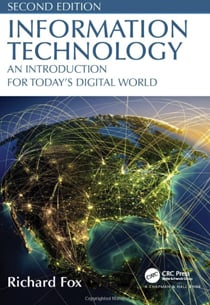Book Review: Information Technology: An Introduction for Today’s Digital World, Second Edition
 Information Technology: An Introduction for Today’s Digital World, Second Edition. By Richard Fox. Taylor & Francis Group, LLC; taylorandfrancis.com; 561 pages; $89.95.
Information Technology: An Introduction for Today’s Digital World, Second Edition. By Richard Fox. Taylor & Francis Group, LLC; taylorandfrancis.com; 561 pages; $89.95.
As the world’s shortage of cybersecurity experts continues or increases, this book proves to be a welcome tool for any security professional striving to enter the cyber arena. It is a good introduction to information technology for IT novices at any stage of life or career and for any reason.
In the preface, Richard Fox leaves little doubt about what is new in his second edition. With nearly 600 pages, the book doesn’t spare coverage of the usual concepts, operations, functions, and issues of cybersecurity. Readers are treated to chapters on the central processing unit and memory, storage and input/output devices, the binary numbering system, the operating system, computer networks, software, programming and languages, information security, Windows, and Unix and Linux.
Implicit in Fox’s aggressive updating is the speed with which modern cyber operations can soon become outdated. As a result, many professionals may feel pressed to devour exam guides to rapidly achieve the required certifications and unhappily learn later that much more preparation is needed for the uninitiated to succeed. Fox’s volume is intended for undergraduates, allowing for the extra degree of patience usually required for newcomers.
Moreover, contrary to the often alienating highly technical, dry, and impersonal discourse in many other cyber textbooks, Fox employs a generally lighter and disarming tone, one that allows for occasional elements of humor.
As undergraduates might already know, this and other volumes of its kind remind that, for many of us, mastering cybersecurity could take several years rather than a few months. For those still pursuing certification, the book can provide important prerequisites before attempting to master the more sophisticated levels, particularly the one sometimes referred to as the gold standard or holy grail: the Certified Information Systems Security Professional, or CISSP.
Reviewer: James T. Dunne, CPP, is a member of the ASIS Communities for Extremism and Political Instability and Information Technology Security. He is a senior analyst in the U.S. State Department’s Bureau of Diplomatic Security. Views expressed here are those of the reviewer, and do not necessarily reflect those of the State Department or the U.S. Government.